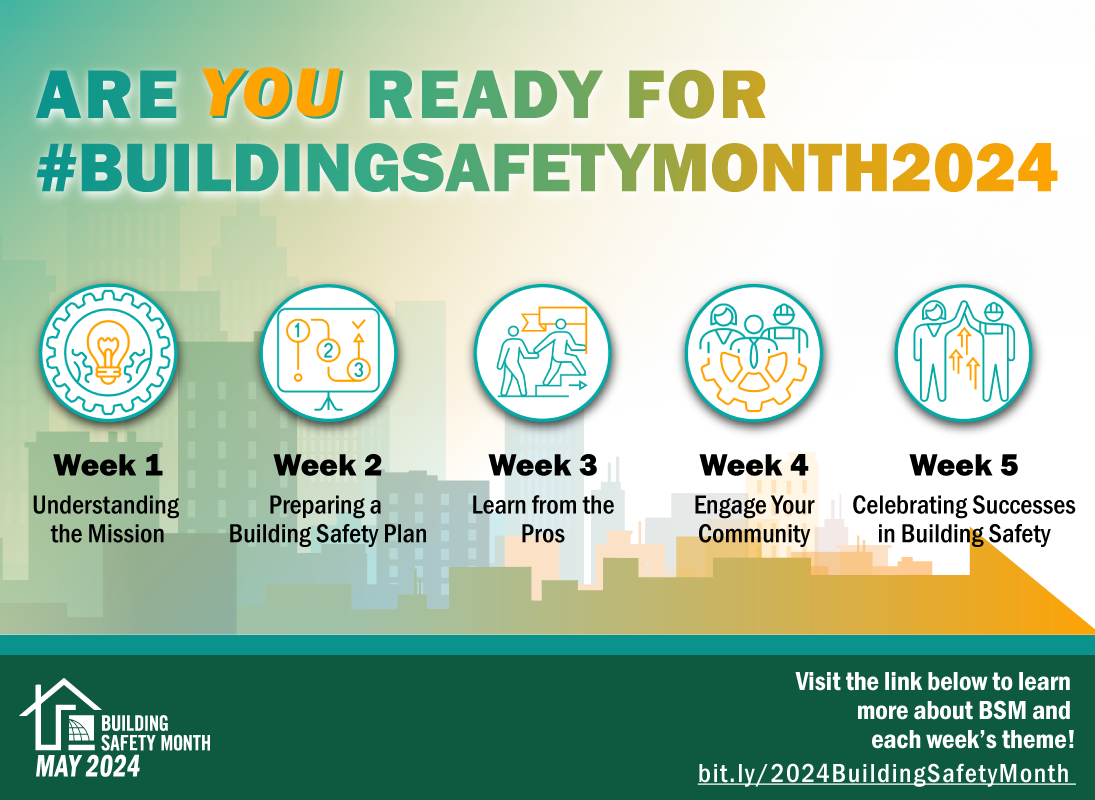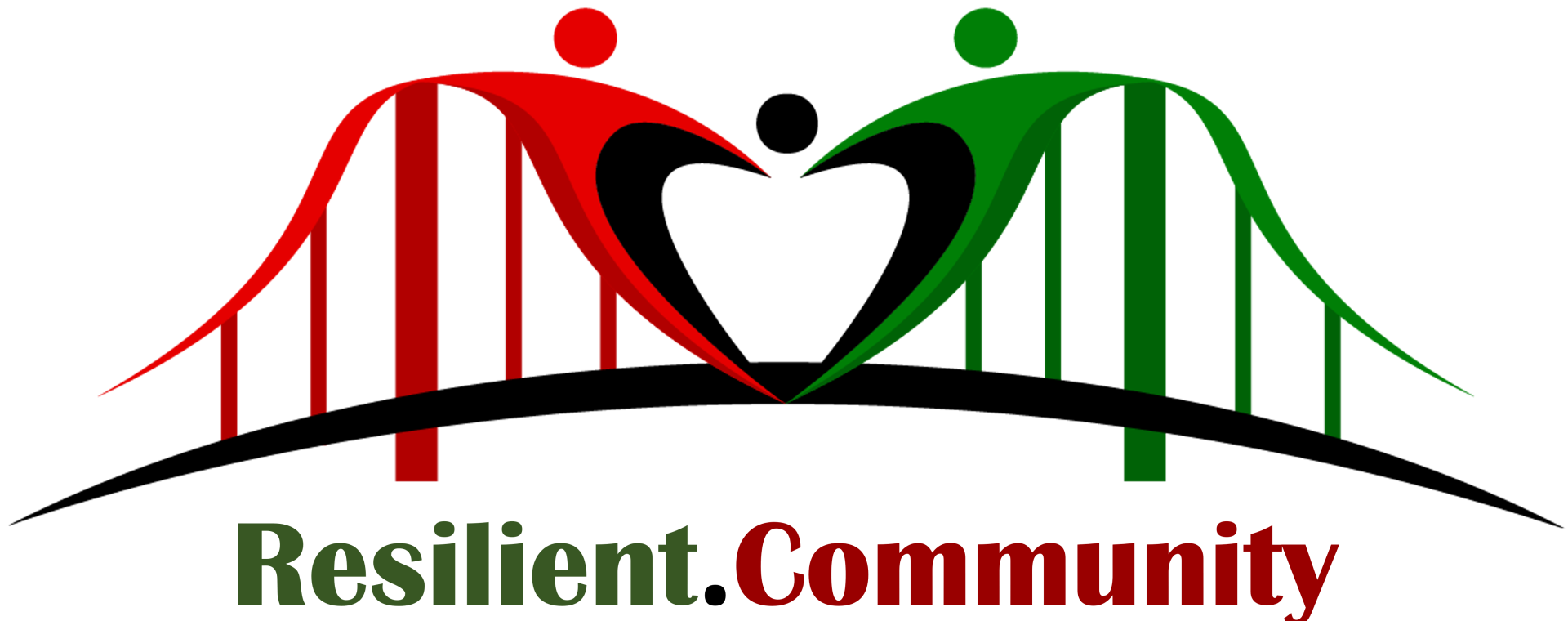FEMA Bulletin week of May 7th 2024
Building Safety Month: Understanding the Mission and Building Code Basics
FEMA is supporting Mission Possible, the 44th Annual National Building Safety Month with the International Code Council (ICC). This month long international educational campaign raises awareness about critical safety issues from structural integrity to fire prevention, plumbing and mechanical systems and energy efficiency.
The first theme week is “Understanding the Mission.” We all have a shared responsibility to ensure the safety of our buildings. To do so, we need to start at the basics. From installing smoke alarms to adopting modern building codes to understanding the crucial role of building safety professionals, FEMA has several resources available to the public on building codes to ensure building safety is a mission we can achieve by working together.
Some of these resources include:
For additional information on the 2024 National Building Safety Month, visit the International Code Council.
Learn more about Building Science on FEMA’s website or contact your local or regional building science point of contact at the agency.

.
FEMA Highlights Employees in Celebration of Asian American, Native Hawaiian and Pacific Islander Month
May is Asian American, Native Hawaiian, and Pacific Islander (AANHPI) Heritage Month a celebration of the culture, history and achievements of AANHPI in the United States.
When considering “Asian American, Native Hawaiian, and Pacific Islanders,” a multitude of cultures are represented. There is a rich tapestry of culture and experience throughout the AANHPI community, which contributes to diversity within FEMA and in the communities that we serve.
The 2024 national theme, “Advancing Leaders Through Innovation” is a continuation of the “Advancing Leaders” series sponsored by the Federal Asian Pacific American Council. “Advancing Leaders Through Innovation” pays tribute to the visionaries and trailblazers who have framed our AANHPI history and continue to influence our collective future.
This week we are highlighting three FEMA employees in honor of AANHPI Heritage Month. Visit FEMA.gov to read the whole blog.
.
FY24 FEMA National Earthquake Hazards Reduction Program State Assistance Grant Applications Available this Month
The Fiscal Year 2024 Notice of Funding Opportunity (NOFO) for the FEMA National Earthquake Hazards Reduction Program (NEHRP) grants will open tomorrow, May 8, and the Individual State Earthquake Assistance and Multi-State and National Earthquake Assistance grants will be available Friday, May 17. To apply these grant funding opportunities, visit www.grants.gov.
- Fiscal Year 2024 FEMA NEHRP Individual State Earthquake Assistance Notice of Funding Opportunity
- Fiscal Year 2024 FEMA NEHRP Multi-State and National Earthquake Assistance Notice of Funding Opportunity
These funding opportunities detail eligibility and submission requirements and provide a program overview, including objectives, priorities and allowable activities.
The application period for each funding opportunity is as follows:
- Fiscal Year 2024 Multi-State and National Earthquake Assistance Notice of Funding Opportunity will open on May 8 and end at 5 p.m. on June 14 ET. All applications must be submitted in FEMA GO.
- Fiscal Year 2024 Individual State Earthquake Assistance Notice of Funding Opportunity will open on May 17 and end at 5 p.m. ET on June 24. All applications must be submitted in FEMA GO.
For more information on FEMA GO please visit FEMA.gov.
FEMA invites stakeholders to visit the NEHRP State Earthquake Assistance Workshop page to view and register for upcoming training for applicants specific to the 2024 funding opportunities.
Additional information on these funding opportunities and FEMA NEHRP is available at FEMA.gov.
Join FEMA’s Webinar to Help Improve the Community Lifelines Construct
Community Lifelines are the most fundamental services in the community that, when stabilized, enable all other aspects of society to function. To help improve the Community Lifelines doctrine within the National Response Framework, FEMA invites all state, local, Tribal Nation and territorial partners to join the webinar series at noon ET on May 9 and 14. The first portion of the meeting will be a review of Lifelines 101 and the second half will be a Q&A session. This is your chance to contribute your thoughts and questions to the discussion.
Please note that the Zoom rooms will be muted for all participants except the host. While registering, participants can submit questions they want answered in the webinar's second part.
Please use the links below to register for the webinars:
If you have questions, email lifelines@fema.dhs.gov.
White House Proclamation for National Building Safety Month
The White House kicked off the 44th annual international awareness campaign about the importance of modern building codes and strong code enforcement. The International Code Council leads this effort each May. President Joseph R. Biden signed a proclamation thanking the many building professionals who make our buildings stronger, more sustainable and more resilient.
Building codes help keep us safe at home, work and in our communities. Two-thirds of communities across our nation have yet to adopt the latest building codes, leaving them vulnerable to fires, floods, storms and extremes to heat and cold. This month is the time for individuals and communities to recommit to the work of keeping the nation’s buildings safe and built to last for generations to come.
As FEMA continues its focus on a Year of Resilience, the five themed weeks support the agency’s focus on building local capacity to withstand tomorrow’s hazards. The campaign – Mission Possible – kicked off the beginning of the month from May 1 to 5, with an introduction to building safety, an understanding of the mission of Building Safety Month and how building safety impacts us all.
The remaining weekly themes include:
Week 2, May 6-12: Preparing a Building Safety Plan
Highlights available educational resources (water/fire, sustainability and resiliency/disaster preparedness), including downloadable brochures, for building safety tips and best practices at home and in your community.
Week 3, May 13-19: Learning from the Pros
Shines a spotlight on building safety professionals, including what they do, how to work with them and how to become one yourself.
Week 4, May 20-26: Engaging Your Community
Includes information on how to advocate for building safety in your community, including actionable tips on how to be a proponent of building safety and ways to get kids involved.
Week 5, May 27-31: Celebrating Success in Building Safety
Highlighting individuals and communities that are making a difference in building safety (editorial spotlights), including sharing the current year's Building Safety Month celebrations and events.
Support this year’s campaign – Mission Impossible – and highlight these themed weeks on social media by using the hashtag #BuildingSafetyMonth2024. For more information on Building Safety Month, visit iccsafe.org.
International Code Council Hosts a Mission Possible Panel to Celebrate Building Safety Month on Thursday, May 16
.

Join the International Code Council and FEMA for a Building Safety Month panel recognizing the 2nd anniversary of the White House’s National Initiative to Advance Building Codes, the progress made to date, and the progress remaining.
Moderated by U.S. Fire Administrator Dr. Lori Moore-Merrell, the event will feature federal, state, and local partners discussing the National Initiative, and the “Mission Possible” of expanding the adoption of resilient codes in hazard-prone and underserved communities in the face of growing disaster risks.
Following the event, in-person attendees are welcome to join the Code Council’s annual Building Safety Month reception. The reception is free and will follow Congressional gift/ethics rules.
Event Details:
- Date: Thursday, May 16
- Time: 4 – 5 p.m. ET
- Location: 200 Massachusetts Ave NW, Washington, DC 2nd Floor Conference Center
- Livestream: 2024 Building Safety Month Webpage
Register for the in-person event here. If you are unable to attend in person, visit the Building Safety Month homepage during the event to view the livestream.
FEMA Announces Two More Activated States, Allocations for FY23 Swift Current
FEMA announced that Michigan and Washington are each eligible for up to $20 million in funding to reduce flood risks through the fiscal year 2023 Swift Current funding opportunity.
This announcement complements the April 17 announcement of 16 states and one Tribal Nation being eligible for up to $295 million for the same funding opportunity.
FEMA will distribute funding on a rolling basis as eligible applicants submit applications until the total available funding amount of $300 million is exhausted. To view a list of the allocations, visit FEMA.gov.
The opportunity aligns with the Year of Resilience theme to build local capacity to withstand tomorrow’s hazards.
The applicant must meet the Swift Current activation criteria, including a major disaster declaration for a flood-related disaster event from June 1, 2023, through May 31, 2024. Flood-related disaster events include coastal storms, hurricanes, remnants of hurricanes and floods. Additional criteria can be found on FEMA.gov.
This funding opportunity is made available using President Biden’s Bipartisan Infrastructure Law funds. Swift Current funds can make homes safer and more resilient for National Flood Insurance Program policyholders with repetitively and substantially flood-damaged buildings as soon as possible after a flood-related disaster. Projects eligible for this funding include property acquisition and demolition, elevation and relocation. Buildings must be insured through the National Flood Insurance Program to be eligible.
The application period for this opportunity opened on Nov. 15, 2023. All eligible applicants must submit their FY 2023 Swift Current grant applications to FEMA via MT eGrants. Upon Swift Current activation, FEMA will provide the application deadline to the applicant.
The application deadlines are for the applicants only. Local governments should consult with their state, Tribal Nation or territorial agency to confirm deadlines for submitting subapplications for consideration.
FEMA will work with states, Tribal Nation and territories to explore their participation during this cycle. Potential applicants with questions may contact their FEMA regional office, while interested subapplicants should contact their state or territory hazard mitigation officer.
FEMA Seeking Feedback on Draft “Engaging Faith-Based and Community Organizations: Planning Considerations for Emergency Managers”
FEMA and the DHS Center for Faith-Based and Neighborhood Partnerships are seeking feedback on the draft, “Engaging Faith-Based and Community Organizations: Planning Considerations for Emergency Managers.”
Originally released in 2018, this document outlines best practices for engaging faith-based and community organizations before, during and after disasters to help jurisdictions improve their resilience and emergency management capabilities. Once engaged, these organizations become significant force multipliers, particularly in reaching high-risk and historically underserved community members. Lessons learned from real-world events and updates to FEMA programs since 2018 have resulted in additional considerations and resources for faith-based and community organizations.


